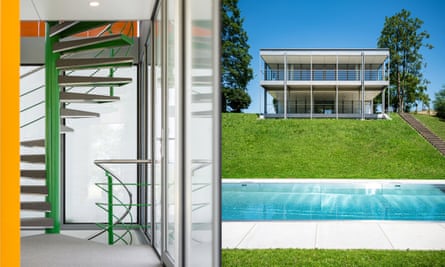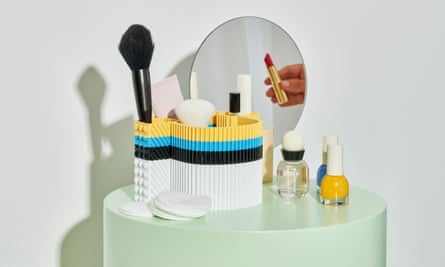Life finally starts to feel like it’s shuffling forward now, with a path out of lockdown and the vaccination programme throwing doors open for the first time in a year. There’s optimism to be found in new sustainable buildings recognised by the EU Mies Award for contemporary architecture and new “warm” technology which keeps people connected and a chance to support the craft industries this week at the Collect Art Fair.
For more design features, sign up to the Design Review newsletter
The house that Fritz Haller built

Taking its name from founder Ulrich Schärer and the Swiss village of Münsingen where the family-owned company is still based, USM modular furniture is a 136-year-old brand known for its functional, sustainable and high-quality products. Sheet-steel panels that can be joined together in endlessly versatile possibilities. The USM Haller System, designed in conjunction with architect Fritz Haller, is still used in open-plan offices around the world today. It is furniture that defies trends, that is sustainable by intention.
When Zürich’s Museum of Design recently moved into new premises, it faced a problem. For the first time a 150-year-old collection comprising half a million examples of graphics, posters, textiles and furniture was housed under one roof. How were they going to display it all? They soon realised the solution was staring them in the face: USM modular furniture that had been part of its permanent collection for decades.
Haller also built USM’s company building (1963), office pavilion (1965) and the Schärer family’s private residence (1968), all of which follow the company’s functional design principals. The latter, built on a steep slope with commanding views in every direction, has now been meticulously renovated in accordance with the original construction principals and historic preservation guidelines.
“It’s where my sister and I grew up,” explains Alex Schärer, the fourth generation of the family and USM CEO. “I lived there from the age of five until I went to college at 18. The family home is important to me personally but this house is particularly important to the company. It was the prototype of a building system designed by Fritz Haller and manufactured under the guidance of my father.
“[Haller] was a visionary, who constantly sought to reduce any solution to its simplest form. He always arrived at rigorous lasting solutions, and the USM Haller product is testament to that, nearly 60 years later.”
Inspiring craft at the Collect Art Fair

Collect, the only fair dedicated to contemporary craft, launches online this week. Replacing the usual pilgrimage to London’s Somerset House to see some of the best designs created by craftspeople in the last five years, online art platform artsy.net is collaborating with the Crafts Council to host Collect. This year 32 exhibitors will present work by more than 400 artists from 35 different countries including the UK, Thailand, Japan and the USA.
There’s a strong interest in crafts at the moment. A 2020 report Crafts Council report Market for Craft found that 73% of participants had bought craft in the last year, with a third of shoppers aged under 35. These new fans will find lots to enjoy at Collect including jewellery from House on Mars, ceramics by Ting-Ying gallery and lacquer craft from The Gallery by SOIL.
Also look out for free virtual events and talks across art, fashion, interiors and culture, including a conversation between ceramicist Magdalene Odundo and Gus Casely-Hayford, director of the V&A East, and Edmund de Waal talking about the meaning of craft today.
Collect Art Fair runs from 26 February - 2 March 2021
Sustainable homeware by Supernovas

“Supernovas never die, they just explode creating new stars.” So reads the manifesto of circular design company Supernovas, founded by designer Massimiliano Rossi, which aims to reuse, recycle, reimagine and reinvent products for homes and businesses. Launched last year with offices in London and Milan, the company’s debut collections are Volta, a bright, Lego-y tableware range designed by Brazilian clothes and homeware designer Paula Cademartori, and Afterlife, a biopmorphic furniture line created with Dutch design studio Odd Matter. All products are made from recycled plastic waste such as bottles, pipes, toys and product packaging. And to make sure their products never become waste, Supernovas has created Streaming, a subscription service that lets customers swap or return products when they tire of them.
As well as making their own creations, Supernovas works with businesses on sustainability and circular economy strategies, from waste material collection to product design. Projects in their first year include making 3D-printed mugs out of rubbish from a music festival and working with the first Italian fast food restaurant made entirely from recycled materials.
The legacy of artist Jason Polan

Artist Jason Polan’s sketches and ideas were unique. His ideas were both inclusive and often definitive. His projects include the art book The Every Piece of Art in the Museum of Modern Art Book and a sketch column for the New York Times called simply Things I saw. He also started the Taco Bell Drawing Club in 2013, where anyone could come and meet him to sketch and draw at Taco Bell, just off Union Square, New York.
His best known scheme was Every Person in New York, an attempt to draw everyone in the city. People could contact Polan and let him know where they’d be to make sure they were included and he also just sketched everyone he laid eyes on. The project blog is full of frenetic sketches with titles such as Three People on Q Train December 10, 2019 or Woman walking up Crosby at Broome December 7, 2016. He’d managed 30,000 portraits by the time he published a book of the work in progress in 2015.
Sadly, there will never be another book. Polan died of cancer last year, aged just 37. This month, Uniqlo has released a clothing collection featuring Polan’s work including Every Person in New York and also asked for people to join The World’s Biggest Drawing Club – posting their own drawings of everyday things – in memory of Polan. It’s easy to imagine Polan appreciating the project - much as he’d like everyday people wearing T-shirts featuring his everyday people and finding something special in it.
Discovering the eclectic pots of Kasama
While Japanese ceramics are world renowned, one fascinating area has yet to find international fame. Kasama in Ibaraki prefecture is surrounded by mountains, a small crucible which has produced a remarkable and eclectic mix of ceramic styles. While Japanese work such as Arita ware or Bizen ware follows centuries of traditions, Kasama’s 250 potters are a small group working in an area with no fixed styles. This may turn out to be their strength. A new initiative organised by Japan’s trade ministry is actively promoting Kasama as a destination for ceramics and fostering a relationship with the potteries of Stoke-on-Trent.

Ryoko Mutasono, the London director of the Kasama Potters project says: “With the recent resurgence of trends in handicraft and craftsmanship, it was hypothesised that the style of Kasama-ware – one unbound by tradition, that allows makers to create freely – would suit the European lifestyle. We believe Kasama’s individual expression could attract new pottery fans.”
Covid permitting, expect to see Kasama-ware at events such as Stoke’s British Ceramics Bicentennial and London Craft Week. To check out the remarkable variety of Kasama pottery from artisans such as Giran Sagawa and Makoto Oki, visit the Kasama Potters website.
New tech created to keep you company

Loneliness and a lack of human contact are two major problems with the prolonged lockdowns of the last year. Last November, the Office for National Statistics found acute loneliness had climbed to record levels, with 8% of adults (around 4.2 million people) feeling “always or often lonely”, and 16-29-year-olds twice as likely as the over-70s to experience loneliness during lockdown.
One Norwegian company – straightforwardly called No Isolation – is focused on using technology to overcome the barriers that keep us apart. They call this “warm” technology. “It’s a term that we’ve coined to describe products specifically designed to enable an engaging communication for people at risk of social isolation and loneliness,” explains Harriet Gridley, UK director of No Isolation. “It’s different from ‘tech for good’, which sees existing tools used towards a good end.”
Its first invention was AV1, a distance-learning robot avatar that acts as a child’s eyes, ears and voice in the classroom. It was developed to help the many children kept out of school by disability or long-term illness, but has clear applications for schools and businesses in the post-Covid world.
“We have all now experienced a degree of social isolation, so there is an increased understanding of those for whom this is the norm. It has also led to a rapid digital wave in schools and care homes, as they have been forced to improve their infrastructures and skills,” says Gridley.
KOMP is No Isolation’s latest product – a one-button computer for groups who are not experienced with digital technology to share photos and make video calls.
“Not everyone has the ability to go back to school, work, or whatever ‘normality’ is after this pandemic,” says Gridley. “Even as lockdown lifts, there will still be many thousands of people who justly feel that society has designed them out of the frame – our job at No Isolation is to design them back into it.”
Celebrating the best European architecture

This month, the nominated entries for the European Union Prize for Contemporary Architecture – Mies van der Rohe Award have been announced. More snappily known as the EU Mies Award, this biennial prize for contemporary European architecture promotes and rewards aesthetic and technological excellence in design and construction, especially for projects which are also a response to the ridiculous times we live in. This set of buildings were mainly commissioned during the financial crisis of 2007-2012 and completed during the Covid pandemic – all against a backdrop of climate crisis and social unrest.
“The EU Mies Award shows that quality can be understood in many different ways but that it must always be connected to the challenges with the environment and make cities and infrastructure more sustainable and resilient” says Anna Ramos, director of the Mies van der Rohe Foundation.
Though it’s wrong to have favourites, the new bus station in Vilkaviškis, a regional Lithuanian town, feels like the epitome of these architectural objectives. Built by Balcytis Studija, the bus station works not only as a transport hub but also as a green space and social arena which can host markets and concerts. None of this involves compromising the modernist glamour of the station.
The next set of Mies Award nominees are released in September.
